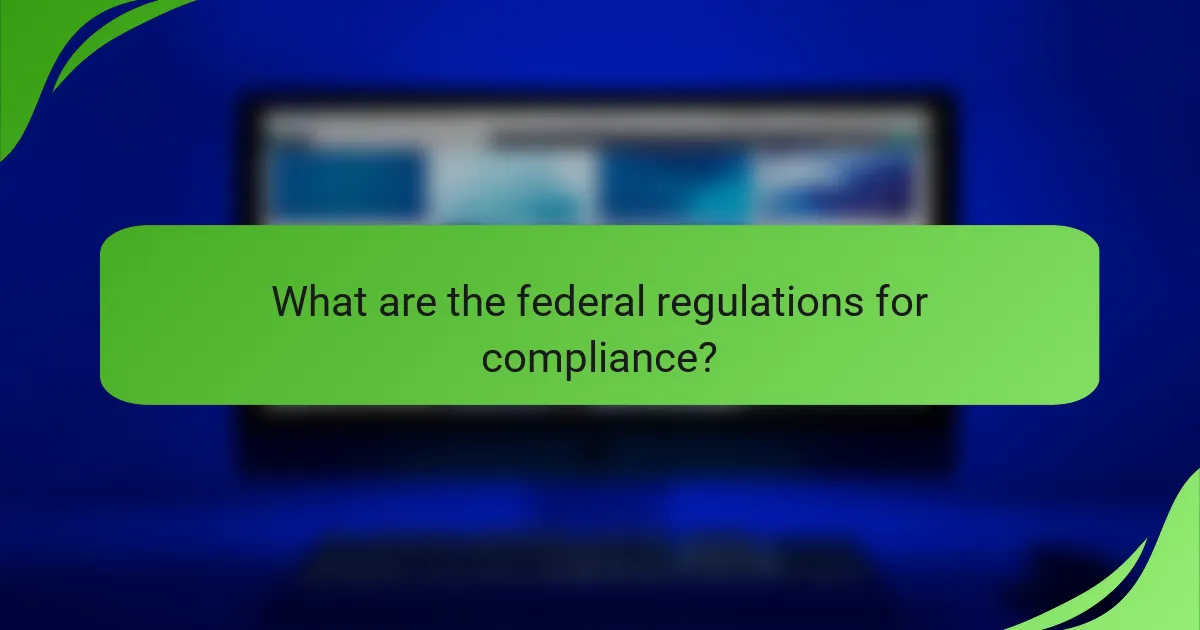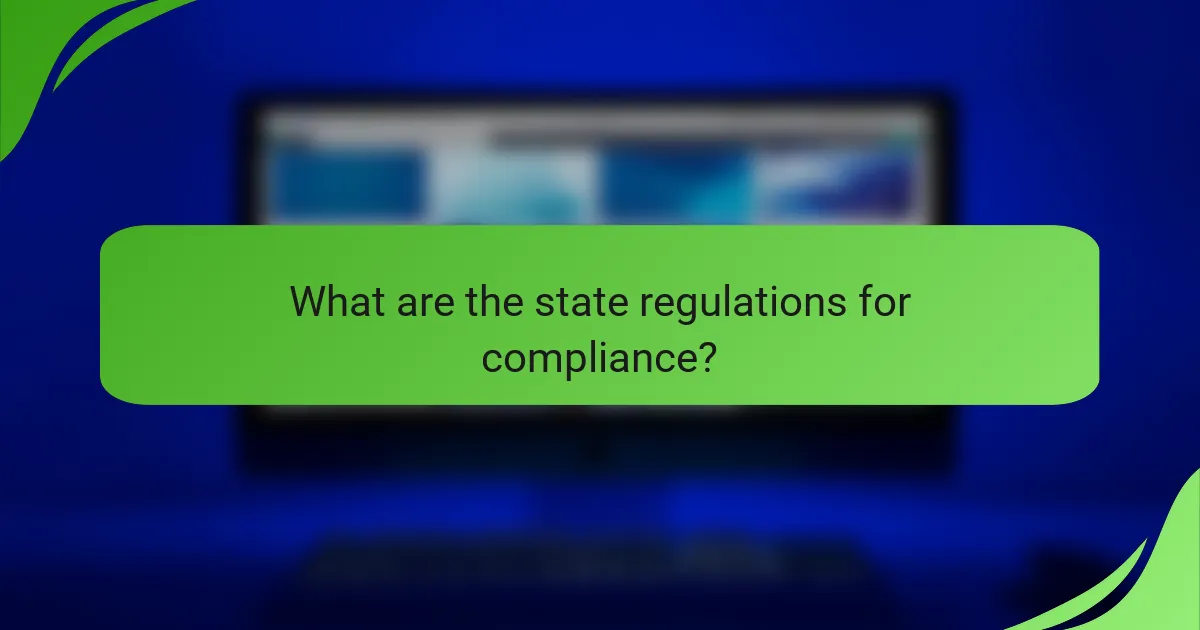Understanding federal and state regulations is crucial for businesses aiming to ensure compliance and uphold industry standards. Federal regulations provide a uniform framework across the nation, addressing key areas such as workplace safety and environmental protection. In contrast, state regulations can differ widely, reflecting local priorities and legal requirements, which can impact how businesses operate within their specific jurisdictions.

What are the federal regulations for compliance?
Federal regulations for compliance are rules established by government agencies to ensure that businesses operate safely and responsibly. These regulations cover various areas, including workplace safety, environmental protection, and consumer rights, and are essential for maintaining standards across industries.
Occupational Safety and Health Administration (OSHA) standards
OSHA standards are designed to ensure safe and healthful working conditions for employees. These regulations require employers to provide a workplace free from serious hazards, implement safety programs, and maintain proper records of workplace injuries and illnesses.
Employers must comply with specific standards related to various industries, such as construction, maritime, and general industry. For example, construction sites must adhere to regulations regarding fall protection, scaffolding, and personal protective equipment (PPE).
Environmental Protection Agency (EPA) regulations
EPA regulations focus on protecting the environment and public health by controlling pollution and managing hazardous waste. These regulations require businesses to comply with standards for air and water quality, waste disposal, and chemical safety.
Companies must often obtain permits for emissions and discharges, and they are subject to inspections to ensure compliance. For instance, manufacturing facilities may need to monitor their emissions and report them to the EPA regularly to avoid penalties.

What are the state regulations for compliance?
State regulations for compliance vary significantly across the United States, focusing on environmental standards, workplace safety, and consumer protection. These regulations are designed to ensure that businesses operate within legal frameworks that protect public health and the environment.
California Air Resources Board (CARB) standards
The California Air Resources Board (CARB) sets stringent air quality standards aimed at reducing air pollution and greenhouse gas emissions. Businesses must comply with regulations that cover vehicle emissions, industrial processes, and consumer products.
For example, CARB requires manufacturers to meet specific emissions limits for vehicles and engines, which are often stricter than federal standards. Companies should regularly review CARB guidelines to ensure compliance and avoid penalties.
New York Department of Environmental Conservation (DEC) regulations
The New York Department of Environmental Conservation (DEC) enforces regulations that protect the state’s natural resources and public health. This includes oversight of waste management, water quality, and air emissions.
Businesses operating in New York must adhere to DEC regulations, which may involve obtaining permits for certain activities, such as waste disposal or emissions discharges. Regular audits and compliance checks are advisable to maintain adherence to these regulations and avoid fines.

How do federal and state regulations differ?
Federal and state regulations differ primarily in their scope, enforcement, and specific standards. Federal regulations apply nationwide, while state regulations can vary significantly from one state to another, reflecting local priorities and conditions.
Scope of enforcement
The scope of enforcement for federal regulations is broad, covering all states and territories, with agencies like the Environmental Protection Agency (EPA) and the Occupational Safety and Health Administration (OSHA) overseeing compliance. In contrast, state regulations are enforced by state agencies, which may have different priorities and resources, leading to variations in how strictly regulations are applied.
For example, a federal environmental regulation may set a baseline standard, but individual states can impose stricter rules based on local environmental concerns. This means businesses operating in multiple states must navigate a complex landscape of compliance requirements.
Variability in standards
Variability in standards is a significant aspect of the difference between federal and state regulations. Federal standards tend to be more uniform, providing a consistent framework across the country, while state standards can differ widely. This can lead to confusion for businesses that must comply with multiple sets of regulations.
For instance, while the federal minimum wage is set at a specific rate, many states have established higher minimum wages. Companies must be aware of these differences to ensure compliance and avoid penalties. Regularly reviewing both federal and state regulations is essential for maintaining compliance and understanding local requirements.

What are the benefits of compliance?
Compliance with federal and state regulations offers several advantages, including reduced legal risks and an enhanced reputation. Organizations that adhere to these standards can avoid costly penalties and build trust with clients and stakeholders.
Reduced legal risks
One of the primary benefits of compliance is the significant reduction in legal risks. Organizations that follow regulations are less likely to face lawsuits, fines, or other legal actions. For example, companies that comply with data protection laws can avoid hefty penalties that can reach millions of dollars.
To minimize legal risks, businesses should conduct regular audits and training sessions to ensure all employees understand compliance requirements. Implementing a robust compliance program can help identify potential issues before they escalate into legal problems.
Enhanced reputation
Compliance can greatly enhance an organization’s reputation among customers, partners, and the public. Companies that demonstrate a commitment to ethical practices and regulatory adherence are often viewed as more trustworthy. This can lead to increased customer loyalty and potentially higher sales.
To leverage this benefit, organizations should actively communicate their compliance efforts through marketing materials and public relations. Highlighting certifications and adherence to industry standards can further bolster credibility and attract new clients.

How to ensure compliance with regulations?
Ensuring compliance with regulations involves a systematic approach that includes regular assessments and employee education. Organizations must stay updated on applicable federal and state laws to avoid penalties and maintain operational integrity.
Regular audits
Conducting regular audits is essential for compliance as it helps identify gaps in adherence to regulations. These audits should be scheduled at least annually, but more frequent checks may be necessary depending on the industry and specific regulations.
During an audit, review processes, documentation, and employee practices to ensure they align with current standards. Utilize checklists to streamline the audit process and ensure all critical areas are covered, such as financial records, safety protocols, and data protection measures.
Employee training programs
Implementing employee training programs is crucial for fostering a culture of compliance within the organization. Regular training sessions should cover relevant regulations, company policies, and best practices to ensure all employees understand their responsibilities.
Consider using a mix of training methods, such as workshops, e-learning modules, and hands-on exercises, to cater to different learning styles. Evaluate the effectiveness of training through assessments and feedback to continuously improve the program and address any knowledge gaps.

What are the costs associated with compliance?
The costs associated with compliance can vary significantly depending on the industry, the specific regulations involved, and the size of the organization. Generally, these costs can be categorized into initial setup costs and ongoing operational expenses, both of which require careful budgeting and planning.
Initial setup costs
Initial setup costs for compliance typically include expenses related to implementing necessary systems, training staff, and acquiring certifications. For instance, a company may need to invest in software solutions to track compliance metrics or hire consultants to guide them through the regulatory landscape.
These costs can range from a few thousand to several hundred thousand dollars, depending on the complexity of the regulations and the scale of the business. Organizations should conduct a thorough cost-benefit analysis to ensure that the investment aligns with their compliance goals.
Ongoing operational expenses
Ongoing operational expenses for compliance involve costs that recur regularly, such as staff salaries for compliance officers, routine audits, and continued training programs. These expenses are crucial for maintaining compliance and can represent a significant portion of the operational budget.
Typically, businesses might allocate anywhere from 1% to 5% of their total revenue to cover these ongoing costs. It’s essential to monitor these expenses closely and adjust as necessary to avoid compliance lapses that could lead to fines or other penalties.

What are the prerequisites for compliance?
To achieve compliance with federal and state regulations, organizations must first identify the specific regulations that apply to their industry and operations. This involves understanding the legal requirements, standards, and best practices relevant to their business activities.
Understanding applicable regulations
Applicable regulations vary by industry and location, encompassing federal laws, state laws, and local ordinances. Organizations must conduct a thorough assessment to determine which regulations they are subject to, including environmental, health and safety, and labor laws.
For example, a manufacturing company may need to comply with the Occupational Safety and Health Administration (OSHA) standards at the federal level, as well as state-specific environmental regulations. It’s essential to stay updated on changes in regulations to avoid non-compliance penalties.
To effectively manage compliance, businesses should consider developing a compliance checklist that outlines key regulations, deadlines, and responsible parties. This proactive approach helps ensure that all necessary steps are taken to meet regulatory requirements and maintain operational integrity.
